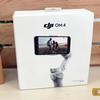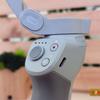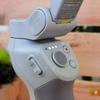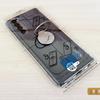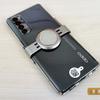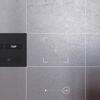The DJI OM4 Smartphone Stabilizer is an extremely useful piece for those who like to shoot a lot of video, travel, shoot sports events, children, blogs and so on. DJI OM4 does an excellent job of its main task of reducing image shake when shooting video on the move, and has a lot of additional modes and functions that will help to make videos more varied. But it is worth remembering that the maximum set of functions will be available only with some smartphones: the flagships of Apple, Samsung and Huawei. Although the cost of the steadicam is 5220 UAH suggests that it will obviously not be used with a budget smartphone. The gimbal is well made, has a comfortable, well thought out folding design and is generally quite easy to learn. And pleases with a long battery life. Should you buy it if you shoot a lot of video and want to improve its quality? Yes. Should you buy the DJI OM4 if you already own the Osmo Mobile 3 and are happy with it? Perhaps not necessary. The difference is not so dramatic.
5 reasons to buy a DJI OM4:
- excellent stabilization;
- convenient, compact and well thought-out folding design;
- simple and intuitive control;
- a large number of modes, functions and capabilities;
- long battery life.
2 reasons not to buy a DJI OM4:
- functionality varies greatly depending on the smartphone
- you already have a DJI Osmo Mobile 3.
What's in the box?
Unlike the DJI Osmo Mobile 3, which was available in two different trim levels, there is only one DJI OM4 variant with everything you need. The stabilizer comes in a large white box with beautiful printing. Inside - the DJI OM4 itself, a detachable tripod, a magnetic clip mount, another magnetic mount in the form of a "washer" with a folding ring, a stencil for correct positioning of the mount on a smartphone, a wrist strap (did not reach us), a carrying pouch, a cable for recharging and the necessary documentation.

How is the DJI OM4 different from the DJI Osmo Mobile 3?
There are only a couple of cardinal differences from the previous model, but they are interesting. The first is the type of attachment. In the previous version, a non-removable rather massive clamp was used. DJI OM4 has decided to switch to a magnetic mount, making it easier to use on the go. There are two mounting options: a metal clip with a magnetic pad and just a magnetic pad with a folding ring, which is glued either to the smartphone itself or to a protective bumper. And in order not to miss a hit, you need the above stencil for smartphones of different sizes. The bottom line is that if the stabilizer is not in use, or you need to answer the call, the smartphone does not need to be pulled out of the clamp, you just need to remove it together with the mount.

The second important innovation is the reinforced motors with increased "carrying capacity". In line with the general trends towards an increase in screen diagonals, dimensions and weight of smartphones. It works with smartphones 230 ± 60 g, 6.9-10 mm thick and 67-84 mm wide. So, if not all, then almost all current smartphones will do.
How does the DJI OM4 look and feel?

The overall design has remained virtually unchanged from the previous version. DJI OM4 is a three-axis foldable and fairly compact gimbal. It is made mainly of rough matte plastic of light gray color. There is a rubberized grip on the handle for a more secure grip. It looks solid and stylish, but the color is not the most practical: with active use, traces will be visible very quickly. When folded, the DJI OM4 takes up very little space and is "on alert" with just a few movements.

The circular magnetic mount is decorated with the DJI logo and has a protrusion at the top for proper connection to the mount. There is a threaded socket on the side, which is designed for counterweights in case of using additional optics or microphones with a smartphone. In general, everything that can shift the center of gravity of the smartphone.

The panel, which is directed towards the owner, houses a joystick, two buttons and LED indicators for operation and charge. We will take a closer look at what and how it works in the next section of the review.

To the right of this site is the Type-C port for charging the stabilizer. To the left is a two-position zoom control slider.
The trigger is present, as in the previous generation. It is multifunctional, responsible for tracking Active Track 3.0 objects, position alignment and stabilization modes.

On the right side, just above the handle, a USB Type-A is hidden under the plug. It is designed to charge the smartphone from the stabilizer during operation if necessary. By the way, the DJI OM4 itself can also be charged while in use.

At the bottom of the grip there is an "eyelet" for attaching a wrist strap. And on the bottom there is a hole with a standard 1/4 tripod thread, to which you can screw either a complete tripod or any other tripod with a standard thread. The complete tripod can be used not only as a tripod: when folded, it can act as a small handle extension.
The design is comfortable, compact and well thought out. In terms of materials and assembly, traditionally for DJI devices, everything is at its best.
How convenient is it to manage and use?
To get started, you just need to unfold the stabilizer, attach the smartphone in the desired way and turn on the stabilizer. There are corresponding protrusions on the fastening and response platforms of the fasteners, so it will be difficult to miss. On a smartphone, this protrusion should be directed towards the upper end. The magnets used are very powerful and accidental dropping of the smartphone is practically impossible. You can only "tear off" a smartphone consciously and purposefully.
Now let's move on to the controls. When the stabilizer is off, pressing the lower button shows the charge level. Long press - turn on. In working mode, a single press on it - switch between photo and video, double - switch between landscape and portrait positions, and triple - switch to standby mode. With the joystick, everything is obvious. The third button is responsible for shooting. Long pressing it in photo mode allows you to take continuous shooting.

The trigger also has several functions. Press and hold - stabilizer lock mode. One tap to start or stop Active Track tracking , double tap to center the gimbal, and triple tap to switch between the main and front camera. Short and then long press - switch to sport mode.

All other settings and capabilities are made using the proprietary DJI Mimo application. And here in this place there is a nuance: yes, how simple the DJI OM4 handheld gimbal will work with virtually any smartphone. But the functionality differs dramatically from model to model. The official website has a list of compatible smartphones and a table with supported functions for each specific model. This does not mean that the gimbal will refuse to work with a smartphone that is not on the list, but the functionality will be limited. For example, there will be support for only the main camera and FullHD video at 30 frames per second, although the smartphone itself supports 4K. Judging by the list, the widest possibilities are on smartphones from Apple, Samsung and Huawei (with the P40 Pro, DJI OM4 was mainly tested). The application can be conditionally divided into two parts. The first is common with videos posted by owners of DJI gadgets, videos and text instructions on using the stabilizer and a simple video editor.
The second part is already directly shooting and setting up the camera and stabilizer. The interface resembles a standard smartphone: "carousel" with shooting modes, zoom settings, white balance, flash, switching between the main and front cameras, video resolution and frame rate. It is noteworthy that with the Huawei P40 Pro, the maximum resolution is 4K, 30 frames per second, although the smartphone itself can shoot 60 FPS. But the application can switch between cameras. For example, in the case of OPPO Reno4 Pro DJI MIMO can use only the main camera, you cannot switch to "shirik". Of the interesting possibilities - there is gesture control. It's just a godsend for the "mother's blogger": with the help of a gesture, you can start video recording, and the stabilizer will follow the person in the frame during recording.
A separate menu item contains the settings for the operation of the stabilizer itself. You can select the follow mode (in fact, the stabilizer operation mode): with fixation along the tilt, along the axis of rotation, from the first person (the smartphone moves smoothly following the user's movements) and the compass (rotation around the axis perpendicular to the smartphone screen). You can also turn on sport mode, adjust the zoom speed, sensitivity, direction and inverse of the joysticks, and calibrate the gimbal. In case you see that the "horizon is obstructed", there is a manual angle adjustment.
How does he behave in work and shoot?

As already written earlier, in the basic version, the stabilizer works with any smartphones. The main basic task of the gimbal is to get rid of shake when filming and make the movements smoother. Especially when shooting on the go: on foot, by bike, skateboard, car. In general, the stabilizer is extremely useful if you take any shots that require moving your smartphone.
After a relatively short time spent experimenting and training, the DJI OM4 can take some really interesting footage. The Active Track 3.0 object tracking system also works very well and rarely misses an object. Within reasonable limits of the object's speed, of course. According to DJI, algorithms are able to find the selected object even if it disappeared from the frame for a split second.
Plus the DJI OM4 has a ton of advanced features and modes. Including the "Story" mode, in which there are prepared templates, you need to shoot several short clips on which effects, background music are applied and everything is glued into one clip. Of course, there is a slow motion mode.
And useful things for a photo. For example, night shooting with a long exposure (which is easy to do given the presence of a tripod), different panorama modes: CloneMe, this is a panorama with a delay so that the user can move to another position. As a result, when gluing on one frame, you get one person twice. And more traditional 3x3, 240 °.


Motion Timelapse or Motionlapse made an impression on the DJI Osmo Pocket . DJI OM4 has this feature too. You can set up to four points of the "route" along which the camera will move, take photos with a certain frequency, and then the video is glued together. You can set the frequency of the photo and the duration of the process, the screen will immediately show the duration of the final video.




